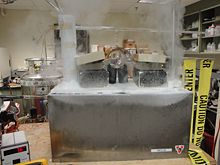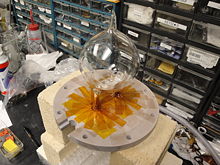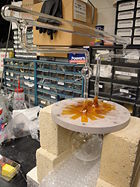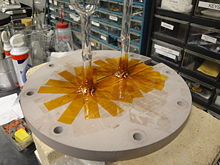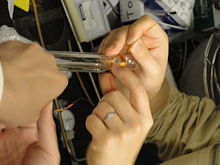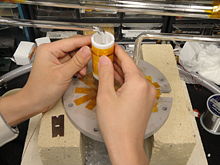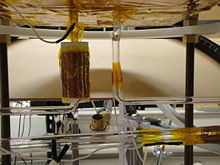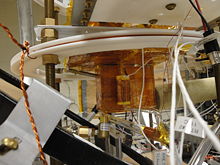Difference between revisions of "Protovec-1"
From Hall A Wiki
(→Cell Mounting) |
(→General Characteristics) |
||
| Line 1: | Line 1: | ||
=== General Characteristics === | === General Characteristics === | ||
| − | * GE180 cell with 5:1 K/Rb alkali ratio and filled to 6.7amg 3He. | + | * GE180 cell with 5:1 K/Rb alkali ratio and filled to 6.7amg 3He. [http://hallaweb.jlab.org/equipment/targets/polhe3/lab/ccell/protovec_1.xls Protovec-1 fill data] |
* Fabricated by Mike Souza mid-July 2011 at Princeton University. Requested [http://hallaweb.jlab.org/equipment/targets/polhe3/lab/ccell/Next_Convection_Cell_16may2011.pdf Cell] and [http://hallaweb.jlab.org/equipment/targets/polhe3/lab/ccell/uva_GE180_string_22apr2011.pdf String] dimensions for Prototype Convection Cell. | * Fabricated by Mike Souza mid-July 2011 at Princeton University. Requested [http://hallaweb.jlab.org/equipment/targets/polhe3/lab/ccell/Next_Convection_Cell_16may2011.pdf Cell] and [http://hallaweb.jlab.org/equipment/targets/polhe3/lab/ccell/uva_GE180_string_22apr2011.pdf String] dimensions for Prototype Convection Cell. | ||
* Filled by Al Tobias Sept 15, 2011 at the University of Virginia. The image below on the left shows the cell attached to the gas system and (sitting on the gas system table) stainless steel tubing that comes down and circles around in a rectangle and back up. This is our ''LHe Cold Trap'' for the purposes of purifiying our 3He gas before it goes into the cell. Both the LHe Cold Trap and the cell are immersed in LHe in our box dewar ''Mollie'', as shown in the image on the right. The 3He gas is first sent thru the stainless steel loop then into the cell. | * Filled by Al Tobias Sept 15, 2011 at the University of Virginia. The image below on the left shows the cell attached to the gas system and (sitting on the gas system table) stainless steel tubing that comes down and circles around in a rectangle and back up. This is our ''LHe Cold Trap'' for the purposes of purifiying our 3He gas before it goes into the cell. Both the LHe Cold Trap and the cell are immersed in LHe in our box dewar ''Mollie'', as shown in the image on the right. The 3He gas is first sent thru the stainless steel loop then into the cell. | ||
Revision as of 11:12, 11 December 2012
Contents
General Characteristics
- GE180 cell with 5:1 K/Rb alkali ratio and filled to 6.7amg 3He. Protovec-1 fill data
- Fabricated by Mike Souza mid-July 2011 at Princeton University. Requested Cell and String dimensions for Prototype Convection Cell.
- Filled by Al Tobias Sept 15, 2011 at the University of Virginia. The image below on the left shows the cell attached to the gas system and (sitting on the gas system table) stainless steel tubing that comes down and circles around in a rectangle and back up. This is our LHe Cold Trap for the purposes of purifiying our 3He gas before it goes into the cell. Both the LHe Cold Trap and the cell are immersed in LHe in our box dewar Mollie, as shown in the image on the right. The 3He gas is first sent thru the stainless steel loop then into the cell.
- Actual Dimensions of Protovec-1. Note about cell dimensions from Al Tobias -- "I regret that we forgot to measure the distance between the transfer tubes right under the pumping chamber. I remember making a rough measurement of the tubes, and found that they are indeed just under 2-inches apart (from central axis to central axis). I'll try to accurately measure this as soon as I have safe access to the cell. Let me know what distance below the pumping chamber your cell holder plate for the oven will attach to the cell's transfer tubes. Also note that I believe I kept the pull-off height less than 1.5" long. This dimension is hard to measure since the pumping chamber is not really spherical. So I measured from the bottom of the pumping chamber to the top of the pull-off."
Buoyancy Measurement
- The sealed glass 3He target cell's internal volume can be determined via the Buoyancy Measurement. To determine the internal volume with this method, one must measure the mass of the cell, mass of cell + block in water and mass of block in water (by itself with cell removed).
Cell Mounting
- At UVa, we mount our cells onto an Alumina Silicate Ceramic plate via Kapton tape. We do not use Silicone RTV (like at JLab) because we like to deliver a clean cell to JLab after our tests at the University. Kapton tape removes cleanly and acetone can help remove any stubborn silicone adhesive that is left behind from the Kapton tape.
- The UVa Oven "cell mounting plate" is 7.0-inch outer diameter round. The bottom or "base plate" of the actual oven is square but has a 5.5-inch
diameter round hole. That leaves about 0.75-inch overlap. We use a red silicone gasket ring to help make air-tight seal when installing mounting plate w/ cell into the oven.
a) convection cell mounting plate with two transfer tube access b) oven bottom or "base plate" with the 5.5-inch hole c) transversity cell mounting plate with single transfer tube access d) front and back walls of oven which hold pump laser windows
- If you mean the height adjustment ceramic piece as the "spacer" I do not have a drawing. It is about 3.325" tall for installing 3.5" Pumping Chamber cells.
Pickup Coils
- Initially, Protovec-1 was fitted with three coils at UVa, in addition to the normal pair used just outside the main oven of the UVa spin exchange optical pumping (SEOP) system. The large solenoid fitted around the transfer tube on the left in the image below is the pNMR coil which has 80-turns of 24-gauge insulated copper wire. The two solenoids on the target chamber are the TC coils which have 50-turns of 24-gauge insulated copper wire each.
Convection Drive Oven
- Here Protovec-1 was installed in transverse mode into the UVa SEOP oven (Oct/Nov 2011). The Convection Drive Oven system forces filtered compressed air thru a HotWatt PF12 Pure Flow Air Heater and into the Drive oven box that encloses the vertical part of the right transfer tube. The Drive oven was constructed with 1/4" thick Calcium Silicate board wrapped in Kapton tape. It has dimensions 4.5" High x 2.0" Wide x 5.5" Deep looking into the oven along the pumping laser beam path.

